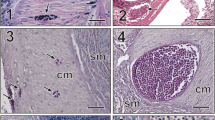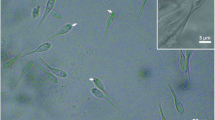Abstract.
Serious loss in the length and weight of the economically important catfish Clarias gariepinus was caused by a high intensity of infestation with Henneguya suprabranchiae, parasites which infect the hyaline cartilage of the suprabranchial organ of fish. Fish were collected from three different localities: the River Nile in the Cairo and Giza provinces, some Giza markets and agricultural drains in Kalyubia province. All harbored cysts at the tips of the secondary bronchioles. These measured between 1.5 and 5 mm in length. The plasmodia of these parasites contained generative cells with immature pansporoblasts at the periphery and mature spores occuping the center. The mature spores were mostly elongate fusiform and had two identical, parallel elongate polar capsules. Each capsule contained a polar filament coiled eight times. There was an iodinophilous vacuole within the sporoplasm. The shell valves extended posteriorly to form two caudal processes. New histopathological lesions caused by these parasites, which are cited to be pathogenic, were studied. Plasmodium growth on the bronchioles was pathogenic. The continuous mass growth of plasmodium in the colony led to pressure on the host cartilaginous tissue which was subsequently compressed. Moreover, this compression induced severe atrophy as well as damage to and destruction of the endothelial lining of the hyaline cartilage. The whole bronchiole tissue was shown to be sloughing and necrotic at the site of infection. In addition, the blood vessels lining the epithelia of the bronchiole were dilated, particularly when large plasmodia were present. A high intensity of infection with several plasmodia may cause a disturbance in the respiratory process of the infected catfish, leading to asphyxia and subsequently to weight loss. In addition, new ultrastructural data on the generative cells, sporogenesis, capsulogenesis, valvogenesis and spore maturation of H. suprabranchiae are presented.
Similar content being viewed by others
Author information
Authors and Affiliations
Additional information
Electronic Publication
Rights and permissions
About this article
Cite this article
El-Mansy, .A., Bashtar, .AR. Histopathological and ultrastructural studies of Henneguya suprabranchiae Landsberg, 1987 (Myxosporea: Myxobolidae) parasitizing the suprabranchial organ of the freshwater catfish Clarias gariepinus Burchell, 1822 in Egypt. Parasitol Res 88, 617–626 (2002). https://doi.org/10.1007/s00436-002-0598-3
Received:
Accepted:
Issue Date:
DOI: https://doi.org/10.1007/s00436-002-0598-3




